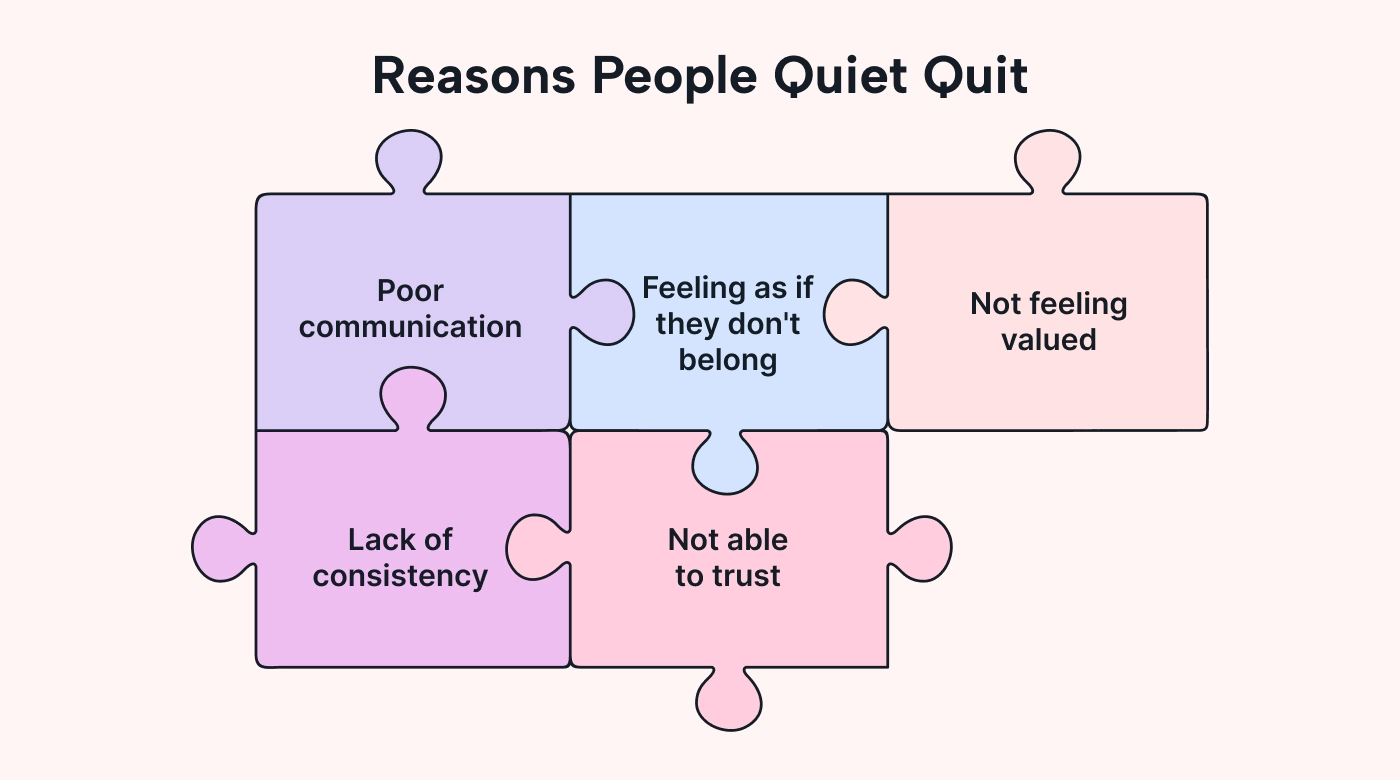At least half of the US workforce is quiet quitting.
But what exactly is quiet quitting, what causes it, and how can you put a stop to it? We’ll answer these questions and more in this article.
What is quiet quitting?
Questions about how real quiet quitting is have been around since the term “quiet quitting” became popular.
But what is quiet quitting?
Quiet quitting happens when employees do only what their job description outlines or only what a task requires — they don’t put in any extra effort or go above and beyond. Rather than actually quitting their jobs, they mentally quit, disengaging emotionally from their work. This might mean no longer seeing any meaning in their role or not allowing their job to have any impact on their identity.
Some quiet quitters will simply not engage in their jobs beyond what’s necessary to pay their bills.
Quiet quitting is particularly unfortunate to see in high performers who typically love their work and derive meaning from it in their lives.
What are the root causes of quiet quitting?
What causes disengaged employees to quiet quit? Let’s take a look.
Poor communication
Poor communication can make employees feel out of the loop, make mistakes, and feel like nothing they do is correct. This leads to them losing interest in going the extra mile.

Feeling as if they don’t belong
Employees who don't feel like part of the team may just stick to ticking off their tasks and not get involved beyond that. This is particularly common in remote teams, where socialization is minimal, and team members don’t get the same chances to bond as they would in the office.
Lack of recognition
When hard work isn't acknowledged or employees see their colleagues are recognized more often than themselves, resentment can grow. This can lead to unhappy employees who lose the motivation to contribute more than the bare minimum.
This also applies to those who are expected to pick up the slack in ways others aren’t. For example, if the same person is always expected to take notes during team meetings, they might begin to wonder why they’ve been singled out. It may be because they are the most detail-oriented or the most active listener — but this needs to be recognized to avoid feelings of resentment.
Inconsistency
Inconsistent rules and practices can make the workplace confusing or frustrating for your team. If they aren’t sure of the best ways to do things or the goalposts keep shifting, this frustration can lead to less effort.
Lack of trust
When the reasons mentioned above all exist, a loss of trust in the workplace can result. Without trust in your leadership or their colleagues, quiet quitters will have one foot out the door.
9 signs of quiet quitting that you may have missed
You might be asking yourself, what does quiet quitting actually look like? Here are nine signs that you might be missing:
1. Employee performance has dropped
Noticing that previously engaged staff are now just doing the bare minimum? They might be procrastinating more, scrolling through social media, or distracting others. This could mean you have quiet quitters.
To help avoid this, hold regular check-ins with employees to identify any issues that have popped up, distribute tasks evenly, and set clear expectations and deadlines. Encourage regular breaks to reduce procrastination and limit workplace distractions by providing quiet spaces.
Try offering more support, too, if employees are genuinely struggling to manage their workload effectively. There could be deeper issues outside of work impacting their work lives.
2. Employees aren’t keeping usual work hours
Are you noticing your staff watching the clock? Maybe they’re simply not taking overtime opportunities — or perhaps they’re packing up a half hour before their shift is done and waiting as the remaining minutes of the workday tick by, even if they haven’t yet finished their tasks.
You might notice staff showing up late or using mouse-moving technology to appear busy and online (this is becoming increasingly common in remote environments).
Or maybe you’ve noticed a sudden increase in absenteeism.

Rather than focusing on the behaviors you want to eliminate (like a lack of punctuality), focus on building a culture that values quality work and outcomes over clocked hours. When staff are trusted to complete their work without feeling constantly monitored, they often take more accountability for the output they produce.
3. Staff show a lack of engagement in their work
A lack of enthusiasm indicates less passion. Quiet quitters lose their drive for career growth and show little interest in professional development or obtaining leadership roles.
Some proactive steps to try to turn this around include giving them meaningful and challenging tasks that match their skill sets, offering them career development opportunities they will find exciting, and recognizing their hard work.
Regularly check in with them on their mental health, too, as a sudden drop in ambition might point to personal issues.
4. There is an obvious lack of motivation
As quiet quitters disengage, they often start showing little effort to go above and beyond their job duties. This can manifest as avoiding helping their coworkers or reluctance to offer ideas.
Their priorities may also seem to have shifted. They could be focusing more on side projects or personal goals than their main job.

To overcome this issue, create a supportive space for teamwork and idea-sharing. Set clear expectations and celebrate those who take initiative. Offer rewards for going above and beyond to re-engage and motivate your team.
5. There are obvious changes in workplace behavior
Highly frustrated quiet quitters might be seen disparaging your workplace, complaining unnecessarily, or negatively affecting morale. They might engage in gossip or even speak to you and management in an unprofessional way.
They might also appear to be unhealthier than usual. This can manifest in signs of burnout — after all, not all quiet quitting is voluntary. Some individuals just struggle to maintain their work-life balance, giving everything they have to their work until they’re forced to focus on their home life and health.
In this case, you need a one-on-one check-in, above all else, to get to the root of the problem. You might need to offer some services for support or set up a professional plan to get the staff member back on track. A formal warning may even be required if the person’s behavior warrants it.
6. Communication has lessened to only what’s required
On the opposite end of the communication spectrum, you might notice that staff are communicating just enough to get by but avoiding deeper conversations. They might now be silent during team meetings or not as sociable as they were before.
One way this can manifest is when previously outgoing employees suddenly withdraw into themselves, using headphones for prolonged periods rather than being part of the office’s social scene.
In this scenario, the employee could be experiencing a deeper issue outside of work. After all, what’s happening in our home life can have a massive impact on our mental health and work performance.
Try having regular, casual check-ins to determine the kinds of support they need. Encourage them to share in a relaxed setting or organize team lunches to rebuild the camaraderie between them and the rest of the team.
7. Staff are isolating themselves
Noticing staff isolating themselves? They might be skipping social events or team-building activities, only socializing with small groups, or preferring to work alone.
While some people are naturally introverted, a sudden change in behavior can signal a deeper issue. If a once-social employee starts withdrawing, it's time for a friendly chat. If they’re not quite ready to open up, wait for them to let you know when they get there.

8. Previously proactive people are now pulling back
Noticing employees who were once proactive pulling away? They may avoid extra projects or new opportunities, stop helping new hires, reduce their working hours, or take more sick days than usual.
To address this, try to determine the cause — is it work-related or personal? Offer resources if something outside of work is affecting them.
Look for solutions together, too. Set clear expectations around hours and sick leave, and consider offering them flexible work options.
9. Quality of work is declining
If you’re seeing a lack of care or effort or outright obvious shortcuts to rush through work tasks, then it’s time to take action.
This is another scenario that requires a one-on-one check-in to get to the root of the problem. Address the issue directly but kindly by asking if they need support. Provide constructive feedback and set clear expectations around work quality. You could even offer additional training or mentorship if needed.
Also, make sure that their workload is manageable, as this helps prevent rushing through and cutting corners. Focused work time is critical for quality work.
Hopefully, you haven’t recognized too many of these signs in your workplace. But if you have, remember that a check-in and an honest conversation can make a huge difference.
3 pro tips to prevent quiet quitting from happening in your workplace
How do you prevent quiet quitting or stop it when it’s already happening? Here are three tips to get you started:
1. Implement measurable retention strategies
Start using measurable retention techniques, like regular employee check-ins and performance reviews, to catch disengagement early.
Keep track of happiness scores and project success rates to tackle issues before they grow. Then, offer specific support, like career development workshops or pairing employees with mentors, to increase job satisfaction and help prevent quiet quitting.
2. Invest in quality professional development opportunities
Invest in quality professional development opportunities to keep your team engaged and growing. Offer specific programs, like leadership training or skill-building workshops, to help your team advance in their careers.
When you invest in upskilling and can show your staff a clear path for growth in their role, you show them you care about their careers beyond the roles they currently fill.

And by showing them that you care about their growth, you boost their commitment to your business in the long term and can build on a culture of continuous improvement and professional development.
3. Tackle quiet quitting head-on with smart tech
Use smart tech to tackle the real reasons behind quiet quitting. Centralize your team's communication and streamline admin to keep everyone connected and informed without having to chase key information.
Implement AI-driven project assistants to handle repetitive tasks, preventing disengagement and even burnout. When your team can focus on creative and more productive work, they can find renewed value in their work.
Use smart task tracking to make responsibilities and progress clear, as this builds accountability and reduces micromanagement — one of the main causes of quiet quitting.
Make quiet quitting a thing of the past with Motion
Spotting the subtle signs of quiet quitting is key to keeping your workplace vibrant and productive. When you notice behaviors like decreased engagement, clock watching, or decreased work quality, it’s time to act.
Motion is here to help.
With Motion, you can make communication a breeze, simplify workflows, and make sure your employees know exactly what to work on and when. When your tasks are centralized and auto-scheduled, you have more time to encourage your employees and help them feel valued and motivated. This not only prevents quiet quitting but boosts overall morale and productivity.
Keep your team engaged, connected, and ready to excel with Motion. Try it for FREE today!

Haylee is a versatile writer with ten years of experience. With a background in marketing and writing for large SaaS companies, Haylee brings her passion for the written word to diverse projects ranging from blog posts and ebooks to direct marketing campaigns.




